At the end of 2012, I wrote a blog, "Ten Christmas Paintings", fully intending to follow it up with a companion blog for Easter, if not in 2013, then certainly much more recently than now. But life is life and without a very long diversion to explain, that has never happened. But now, whether you wish for it or not, that blog is finally to be prevailed upon you.
The handful of you, if that in itself is not an exaggeration, who follow my art blogs, will know they follow certain rules.
They must all be of paintings I have actually seen (with one allowed exception) and they must be from ten different artists (again with one mulligan allowed). And at some point we will stop for lunch. These are the rules but the reader also doesn't take long to realise that my chosen paintings are entirely dominated by Italian Renaissance and Pre-Renaissance Art, for that is with what I am most familiar. Whatever "Pre-Renaissance" means anyway. But that is an argument for another day.
And you might find the occasional reference to contemporary politics dropped in on the way. For that's what I mainly write about. Who knows whether that will happen as I type this, for I haven't finished. Or even really started. So let's get going.
1 Lorinzetti. The Entry of Christ into Jerusalem. Basilica di San Francesco, Assisi.
Where to start is part of the problem. All the concentration in high renaissance art is on the three days (we'll get on to that) but earlier painters saw the wider picture. There is a wonderful Duccio di Buoninsegna cycle in Siena which traces events from before Holy Week right through to the Ascension which I don't even have time for here. Here I only have time for this. I can't even remember which Lorinzetti painted this. Him or his brother. Obviously I could do a bit of googling and sort that out. But it wouldn't matter. It's very early, from the start of the 14th Century. Just to put that in context for Scottish people, around the time of Bannockburn. Like the Duccio, also Sienese. And just, I don't know why exactly, wonderful. At this point I could write another 10,000 words about Lorinzetti and his bro. Not least his (or the other one's) triptych in Arezzo within walking distance of my favourite restaurant in the whole world. But you will be relieved to learn I don't intend to do so.
2. Leonardo da Vinci. The Last Supper. Santa Maria delle Grazie, Milan.
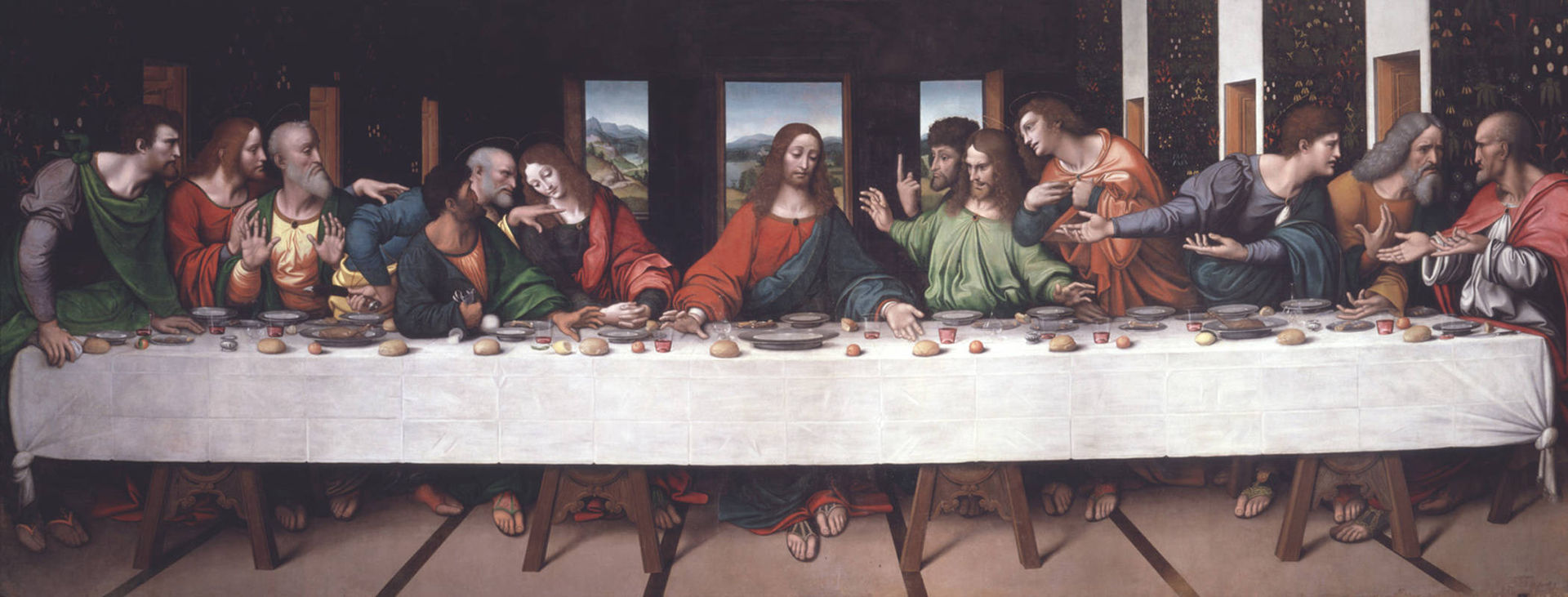
So, let's instead just jump forward. This is where things start, for the first time, to get a wee bit difficult. I get that this is a good painting. A very good painting even. By a man who was, beyond peradventure, a genius. But, I don't know, it just seems a bit.....overrated. I spent twenty years or so wanting to see this and yet , immediately afterwards, I found myself slightly disappointed. It's all just a bit staged. Nonetheless, few paintings have so many conspiracy theories attached. Not least that the the disciple immediately to Jesus's right looks like a woman. (look it up!)
3. The taking of Christ. Goya, The Prado, Madrid.
Now here, lads, you might have been expecting the Caravaggio in Dublin, it is truly grand. However I've already planned ahead to another Caravaggio and would remind you of my own rules above. So this is by Goya. No artist probably painted in such a mixture of styles but this is a fairly traditional image from a very Catholic culture painted at the end of the 18th Century. And, although it is not Caravaggio, you don't need to look very far to spot his influence. More to the point, the painting is in Madrid. I love Madrid for many reasons but principally because it has not one, not even two, but three great art galleries. This is from the Prado, probably the greatest of the three. Nowhere better in the world for Goya, or Velasquez. Or indeed for a wee row on the boating lake just behind.
4. The flagellation of Christ. Palazzo Ducale, Urbino.
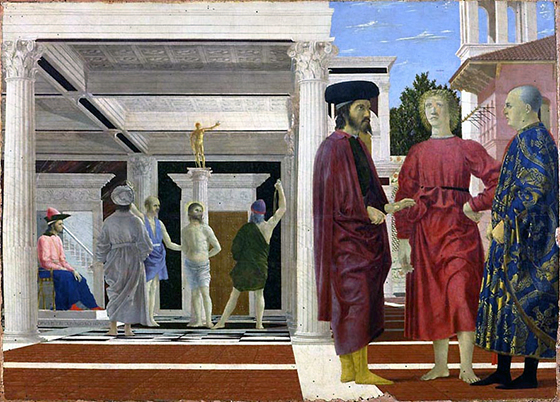
"The greatest small painting in the world". It is tiny, less than two feet across. But so much going on. Analysed expertly here . Urbino is a bit out of the way, over the Mountains of the Moon from southern Tuscany. For as long as I have been going to Italy, they have been constructing a viaducts and tunnels autostrada to cut the journey time. They probably still will be long after I've gone. That's Italy for you. If ever a country needed a strong man leader to bring a bit of ordine and get these great infrastructure projects completed...........I may have taken that too far.
5. The Crucifixion, Velasquez. The Prado, Madrid.
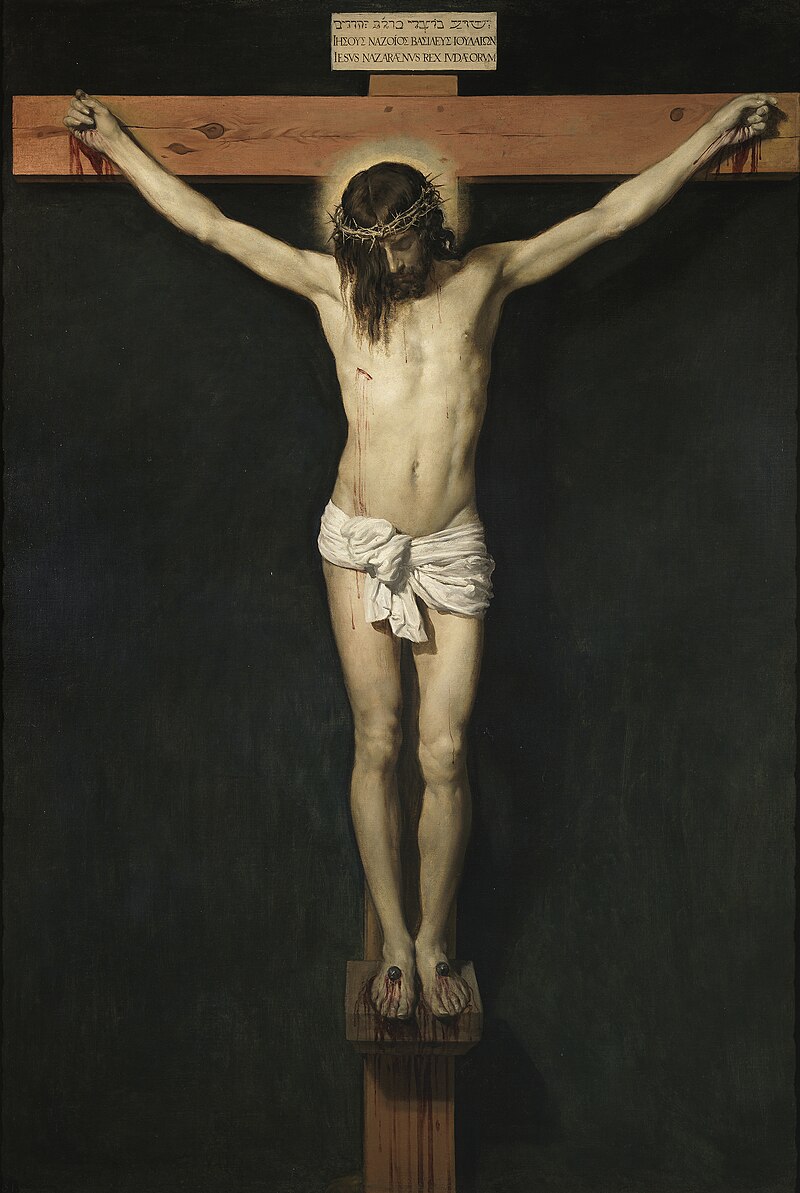
I'm struggling here a bit to contain the narrative, so Simon the Cyrene and Saint Veronica and various other major players will have to wait for any sequel. For the subject at hand, no writer has been more spoiled for choice. Obviously however there are many, many depictions featuring miscellaneous other actors at the foot of the Cross. But, with respect to them, I think that kind of misses the point. This doesn't. A work of genius.
6. Cristo Morto. Mantegna. Pinoteca di Brera, Milan.

Again, for reasons of space, any number of great Depositions have had to go. Similarly Pietas, the greatest of which anyway, to my mind at least, is not in paint but in marble, in the form of Michelangelo's masterwork in St Peter's in Rome. Instead I give you this. I'll confess, I'm not the greatest fan of Milan. It is too "modern" a city for me. And a kind of "Imperial" city, in the model of London or Vienna, without ever having had the Empire to go with it. If you left it up to me, I'd be happily be rushed in and out to see the magnificent Gothic cathedral and the Pinoteca di Brera. Where you will find this. The perspective is stunning. The wounds at centre stage and the grief of the mourners only too real. Reminding you that, for two days, they really did think it was all over. That's all. Although it is obviously not all.
7. The Resurrection. Piero della Francesca. Museo Civico, San Sepolcro.
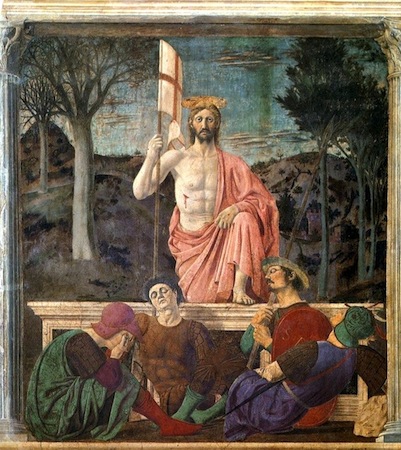
This is my very favourite painting in the whole world, a preference I share, somewhat improbably, with none other than Tony Blair. Notwithstanding Christ's dolorous expression, it is literally, a picture of triumph. Of life over death. I remain firmly agnostic with regard to religion but, when I see the likes of this, I really wish that I wasn't.
By now however you must be starving. And if you've read any of my previous art blogs, you'll know that I like at one point to stop for a bit of lunch.
I was last in San Sepolcro two years past, when the Resurrection was in restauro and therefor only partly visible. The disappointment of this was only compounded by the ticket office offering to sell me a discounted pensioners ticket. The restoration is however now finished and I'm therefor planning to return by the end of June this year. Looking as young as possible. On my way back, I will most likely stop for lunch in Umbertide (I am a creature of habit). There is a wee trattoria, the Locanda Appennino there that I first stumbled upon more than twenty five years past. The food is everything that you would expect but its main selling point is that you eat under a pergola beside, in Summer, the dried up river bed. The flora and fauna are all around you to the extent that you wouldn't be entirely surprised to find St. Francis himself at a nearby table.
Anyway, after an expresso and a digestivo della casa, back to the action.
8. The Supper at Emmaus. Caravaggio. The National Gallery. London

And, finally, to the Caravaggio.
In the Gospels, appearances of the risen Christ are actually relatively rare. This particular one only features, at least as at a specific location, in St. Luke. It is the painting I have seen most recently, for it was on loan to the Caravaggio exhibition at the National Gallery of Scotland last Summer. There is lots of iconography and symbolism within it but you can google that. I'd only draw you attention to both the realism of the characters and, as always, the wonderful use of light. Caravaggio, eh?
9. Noli me Tangere. Giotto. Scrovegni Chapel, Padua.

And so, from the very end of the high period of Italian art, back to the very beginning. The Scrovegni Chapel is one of the true wonders of the world situated in one of my very favourite cities in Italy. But I've also chosen this version of the Noli me Tangere for another reason. To show how the development of Italian art drew down inspiration through the generations. This is a complex picture but look at the sleeping soldiers around the tomb. And then look back to Piero's Resurrection above. The latter was painted 1463-65, while Giotto painted this 1303-1305. more than 150 years before. Yet the influence is obvious.
10. The risen Christ appears to the Apostles. 14th Century unknown artist. Notre-Dame de Paris.
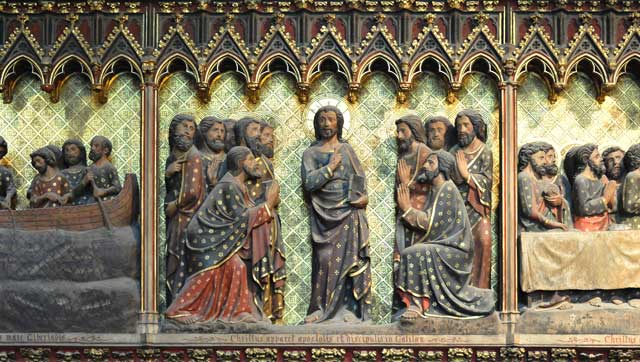
And that is more or less it.
This is the allowed exception that I referred to above. For, although I have been to Notre Dame, if I did see this then I have lost all recollection of having done so.
You don't write something like this blog without a plan, and my plan originally was to finish with the great mosaic of Christ in Majesty in the Cathedral of Monreale, near Palermo. But then this week we had the tragic fire at Notre-Dame. Where this small work may or may not have been destroyed. The extent to which all Europe, indeed most of the world, was seized by the event as it unfolded ranged far wider than those who were practising Christians but I defy anybody not to have been moved by the film of the crowds singing the Ave Maria outside.
I don't like the phrase, Judeo-Christian for two reasons. Firstly it suggests a mutual harmony of co-existence which is hardly borne out by history. In one direction of persecution in particular. But secondly, it implicitly excludes from the conversation the third great monotheistic religion, Islam, in a way that is wholly unjustified. The Renaissance itself would have been impossible without the discovery, among Islamic scholars and in Arabic, of many major Greek texts otherwise lost in their original tongue. The preservation, in Spain, of so many great buildings, originally built as Mosques in the reincarnation of modern Churches and, in Anatolia, of so many great Churches as latter day Mosques demonstrates the appreciation of a common cultural patrimony which exists to this day. As does so much else, not least the "Turkish" influence on as diverse recipients as Holbein, Mozart or, indeed, anyone simply desirous of a humble kebab.
I get annoyed therefor with the suggestion that this is "White Man's" culture from both the side that would claim for it an implied superiority, but equally from the "other" side that suggests that, for that very reason, in the modern age, it shouldn't be routinely taught, or learned, at all.
Easter is the greatest festival of the Christian Church. But, culturally, it belongs to all of us as well.
Enjoy your lamb on Sunday.